University Biology Assignment: Coronavirus Cell Biology Analysis
VerifiedAdded on 2022/08/21
|6
|1378
|76
Homework Assignment
AI Summary
This assignment delves into the cell biology of the SARS-CoV-2 virus, examining its structure, which primarily consists of proteins and RNA. It contrasts the characteristics of life with the capabilities of the virus, concluding that the virus is only 'alive' within a host cell. The assignment also analyzes the evolutionary dynamics of the S and L strains of the virus, explaining how natural selection and the survival of the fittest have influenced their prevalence. It explores the role of the host cell membrane in viral infection, the function of integral proteins like the angiotensin-converting enzyme 2, and the processes of endocytosis and exocytosis in the context of viral entry and exit. The assignment further elucidates the roles of positive and negative RNA strands in viral replication, the importance of proofreading ability in DNA polymerase, and the process of translation within the host cell's ribosomes. Finally, it describes the roles of the endoplasmic reticulum and Golgi apparatus in protein modification and transport, and how viruses utilize these pathways for their own propagation.
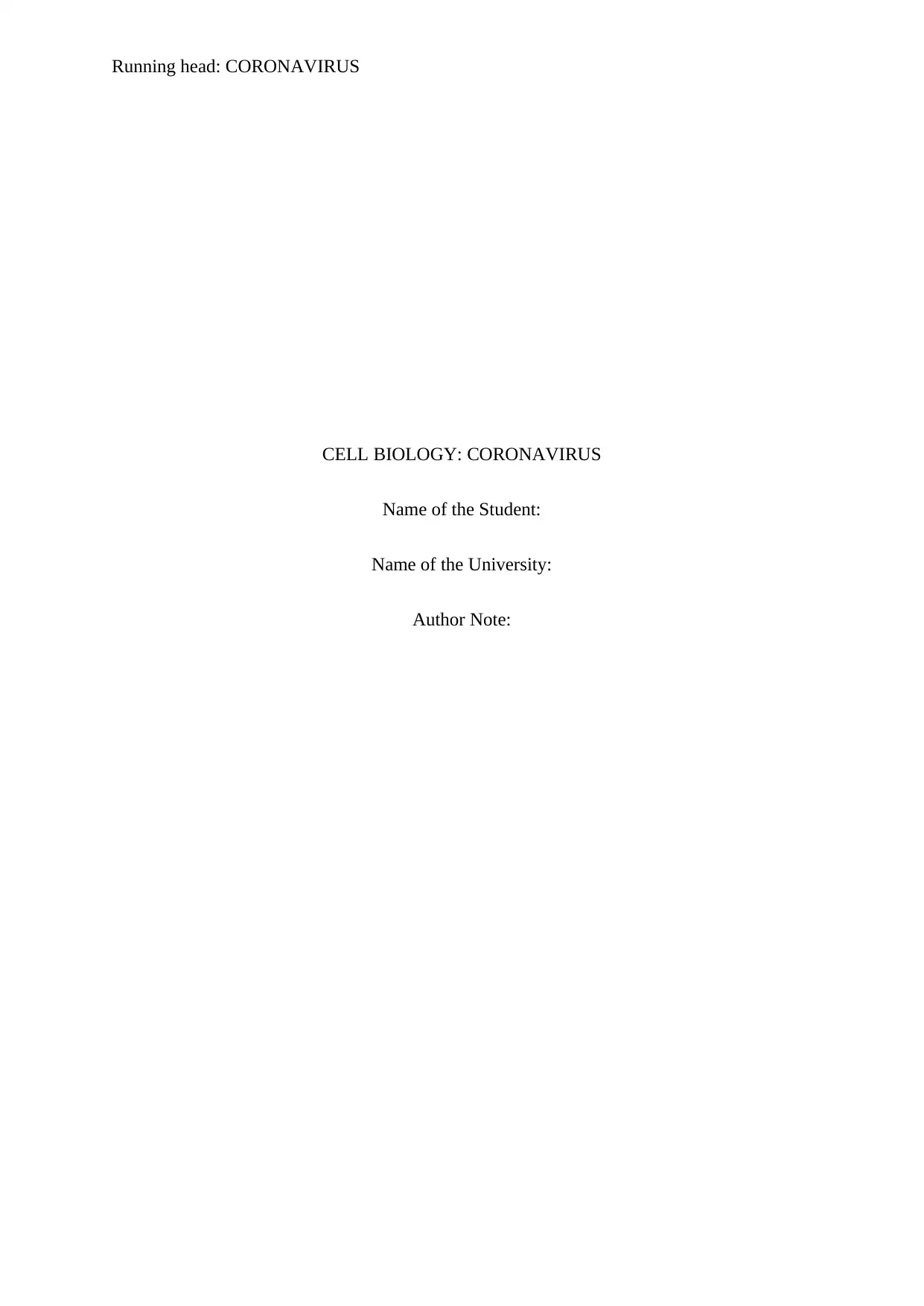
Running head: CORONAVIRUS
CELL BIOLOGY: CORONAVIRUS
Name of the Student:
Name of the University:
Author Note:
CELL BIOLOGY: CORONAVIRUS
Name of the Student:
Name of the University:
Author Note:
Paraphrase This Document
Need a fresh take? Get an instant paraphrase of this document with our AI Paraphraser
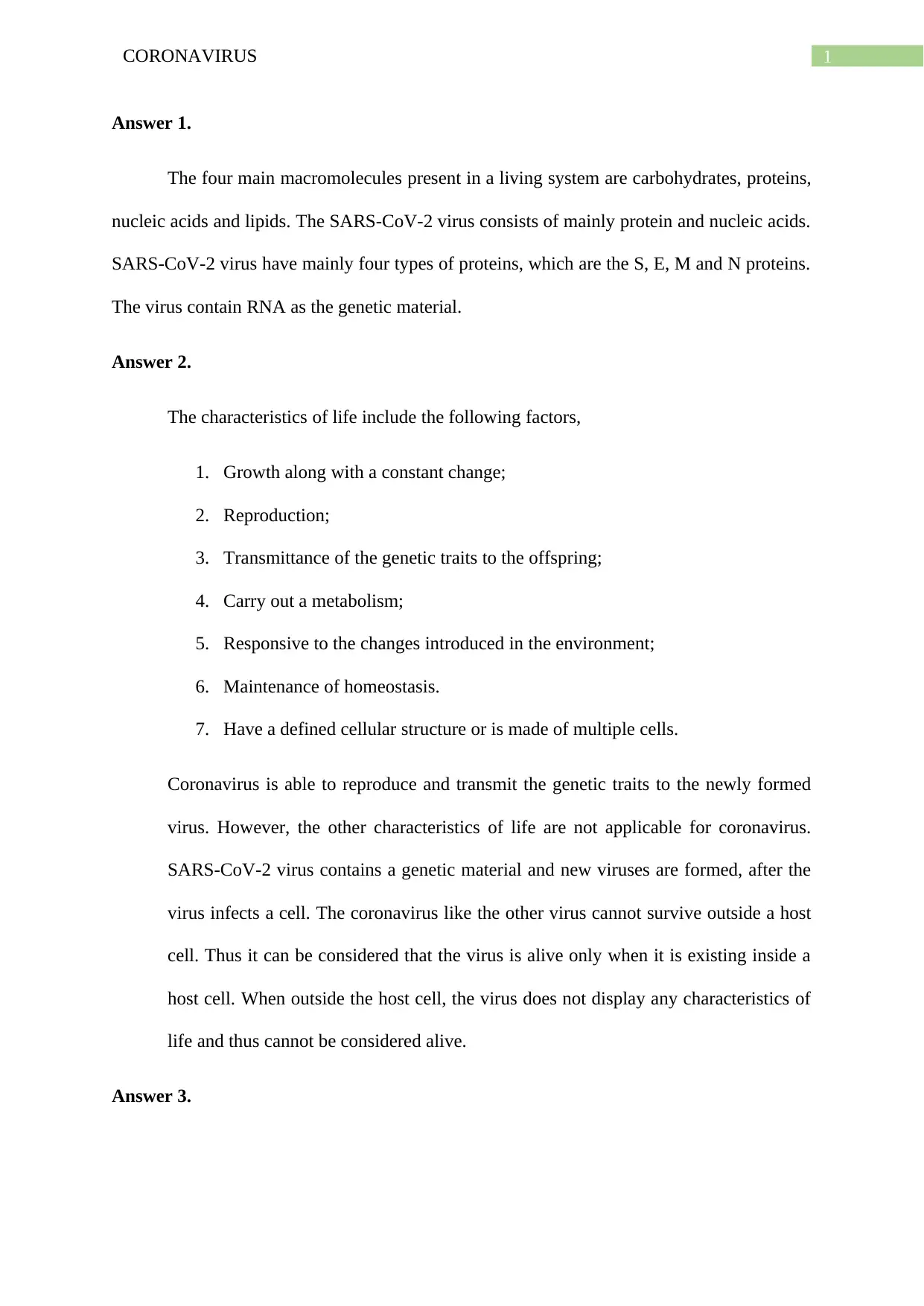
1CORONAVIRUS
Answer 1.
The four main macromolecules present in a living system are carbohydrates, proteins,
nucleic acids and lipids. The SARS-CoV-2 virus consists of mainly protein and nucleic acids.
SARS-CoV-2 virus have mainly four types of proteins, which are the S, E, M and N proteins.
The virus contain RNA as the genetic material.
Answer 2.
The characteristics of life include the following factors,
1. Growth along with a constant change;
2. Reproduction;
3. Transmittance of the genetic traits to the offspring;
4. Carry out a metabolism;
5. Responsive to the changes introduced in the environment;
6. Maintenance of homeostasis.
7. Have a defined cellular structure or is made of multiple cells.
Coronavirus is able to reproduce and transmit the genetic traits to the newly formed
virus. However, the other characteristics of life are not applicable for coronavirus.
SARS-CoV-2 virus contains a genetic material and new viruses are formed, after the
virus infects a cell. The coronavirus like the other virus cannot survive outside a host
cell. Thus it can be considered that the virus is alive only when it is existing inside a
host cell. When outside the host cell, the virus does not display any characteristics of
life and thus cannot be considered alive.
Answer 3.
Answer 1.
The four main macromolecules present in a living system are carbohydrates, proteins,
nucleic acids and lipids. The SARS-CoV-2 virus consists of mainly protein and nucleic acids.
SARS-CoV-2 virus have mainly four types of proteins, which are the S, E, M and N proteins.
The virus contain RNA as the genetic material.
Answer 2.
The characteristics of life include the following factors,
1. Growth along with a constant change;
2. Reproduction;
3. Transmittance of the genetic traits to the offspring;
4. Carry out a metabolism;
5. Responsive to the changes introduced in the environment;
6. Maintenance of homeostasis.
7. Have a defined cellular structure or is made of multiple cells.
Coronavirus is able to reproduce and transmit the genetic traits to the newly formed
virus. However, the other characteristics of life are not applicable for coronavirus.
SARS-CoV-2 virus contains a genetic material and new viruses are formed, after the
virus infects a cell. The coronavirus like the other virus cannot survive outside a host
cell. Thus it can be considered that the virus is alive only when it is existing inside a
host cell. When outside the host cell, the virus does not display any characteristics of
life and thus cannot be considered alive.
Answer 3.
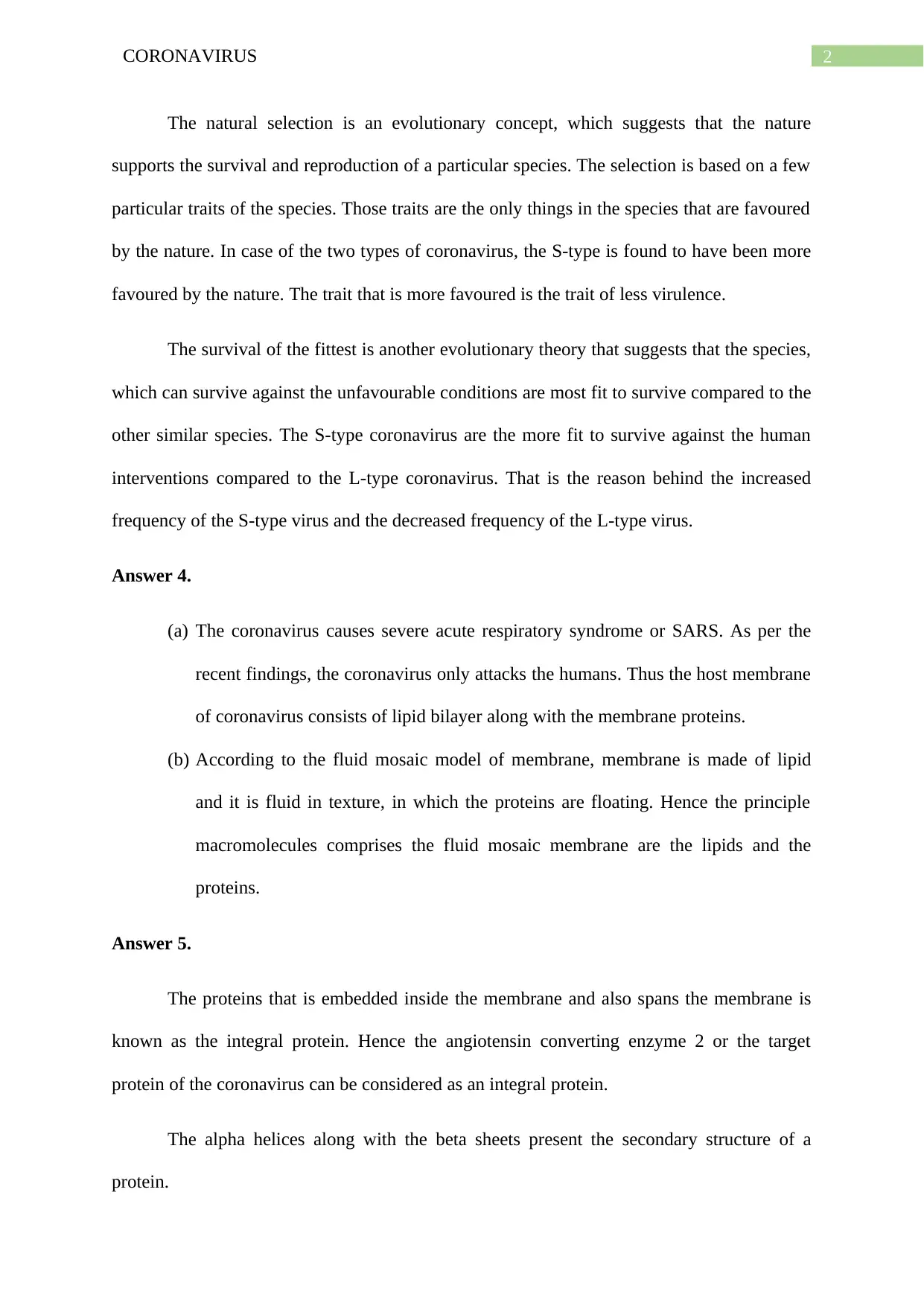
2CORONAVIRUS
The natural selection is an evolutionary concept, which suggests that the nature
supports the survival and reproduction of a particular species. The selection is based on a few
particular traits of the species. Those traits are the only things in the species that are favoured
by the nature. In case of the two types of coronavirus, the S-type is found to have been more
favoured by the nature. The trait that is more favoured is the trait of less virulence.
The survival of the fittest is another evolutionary theory that suggests that the species,
which can survive against the unfavourable conditions are most fit to survive compared to the
other similar species. The S-type coronavirus are the more fit to survive against the human
interventions compared to the L-type coronavirus. That is the reason behind the increased
frequency of the S-type virus and the decreased frequency of the L-type virus.
Answer 4.
(a) The coronavirus causes severe acute respiratory syndrome or SARS. As per the
recent findings, the coronavirus only attacks the humans. Thus the host membrane
of coronavirus consists of lipid bilayer along with the membrane proteins.
(b) According to the fluid mosaic model of membrane, membrane is made of lipid
and it is fluid in texture, in which the proteins are floating. Hence the principle
macromolecules comprises the fluid mosaic membrane are the lipids and the
proteins.
Answer 5.
The proteins that is embedded inside the membrane and also spans the membrane is
known as the integral protein. Hence the angiotensin converting enzyme 2 or the target
protein of the coronavirus can be considered as an integral protein.
The alpha helices along with the beta sheets present the secondary structure of a
protein.
The natural selection is an evolutionary concept, which suggests that the nature
supports the survival and reproduction of a particular species. The selection is based on a few
particular traits of the species. Those traits are the only things in the species that are favoured
by the nature. In case of the two types of coronavirus, the S-type is found to have been more
favoured by the nature. The trait that is more favoured is the trait of less virulence.
The survival of the fittest is another evolutionary theory that suggests that the species,
which can survive against the unfavourable conditions are most fit to survive compared to the
other similar species. The S-type coronavirus are the more fit to survive against the human
interventions compared to the L-type coronavirus. That is the reason behind the increased
frequency of the S-type virus and the decreased frequency of the L-type virus.
Answer 4.
(a) The coronavirus causes severe acute respiratory syndrome or SARS. As per the
recent findings, the coronavirus only attacks the humans. Thus the host membrane
of coronavirus consists of lipid bilayer along with the membrane proteins.
(b) According to the fluid mosaic model of membrane, membrane is made of lipid
and it is fluid in texture, in which the proteins are floating. Hence the principle
macromolecules comprises the fluid mosaic membrane are the lipids and the
proteins.
Answer 5.
The proteins that is embedded inside the membrane and also spans the membrane is
known as the integral protein. Hence the angiotensin converting enzyme 2 or the target
protein of the coronavirus can be considered as an integral protein.
The alpha helices along with the beta sheets present the secondary structure of a
protein.
⊘ This is a preview!⊘
Do you want full access?
Subscribe today to unlock all pages.

Trusted by 1+ million students worldwide
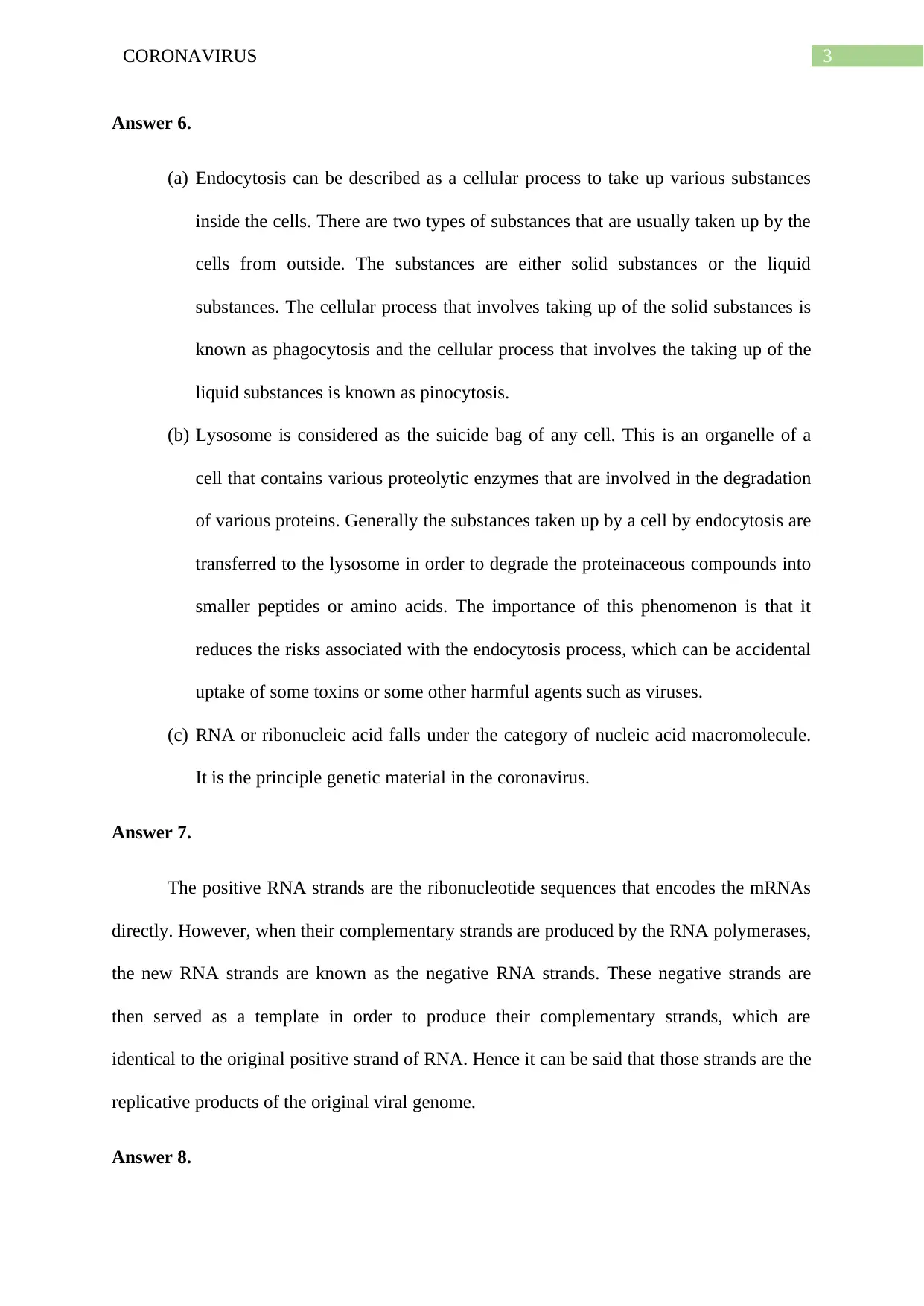
3CORONAVIRUS
Answer 6.
(a) Endocytosis can be described as a cellular process to take up various substances
inside the cells. There are two types of substances that are usually taken up by the
cells from outside. The substances are either solid substances or the liquid
substances. The cellular process that involves taking up of the solid substances is
known as phagocytosis and the cellular process that involves the taking up of the
liquid substances is known as pinocytosis.
(b) Lysosome is considered as the suicide bag of any cell. This is an organelle of a
cell that contains various proteolytic enzymes that are involved in the degradation
of various proteins. Generally the substances taken up by a cell by endocytosis are
transferred to the lysosome in order to degrade the proteinaceous compounds into
smaller peptides or amino acids. The importance of this phenomenon is that it
reduces the risks associated with the endocytosis process, which can be accidental
uptake of some toxins or some other harmful agents such as viruses.
(c) RNA or ribonucleic acid falls under the category of nucleic acid macromolecule.
It is the principle genetic material in the coronavirus.
Answer 7.
The positive RNA strands are the ribonucleotide sequences that encodes the mRNAs
directly. However, when their complementary strands are produced by the RNA polymerases,
the new RNA strands are known as the negative RNA strands. These negative strands are
then served as a template in order to produce their complementary strands, which are
identical to the original positive strand of RNA. Hence it can be said that those strands are the
replicative products of the original viral genome.
Answer 8.
Answer 6.
(a) Endocytosis can be described as a cellular process to take up various substances
inside the cells. There are two types of substances that are usually taken up by the
cells from outside. The substances are either solid substances or the liquid
substances. The cellular process that involves taking up of the solid substances is
known as phagocytosis and the cellular process that involves the taking up of the
liquid substances is known as pinocytosis.
(b) Lysosome is considered as the suicide bag of any cell. This is an organelle of a
cell that contains various proteolytic enzymes that are involved in the degradation
of various proteins. Generally the substances taken up by a cell by endocytosis are
transferred to the lysosome in order to degrade the proteinaceous compounds into
smaller peptides or amino acids. The importance of this phenomenon is that it
reduces the risks associated with the endocytosis process, which can be accidental
uptake of some toxins or some other harmful agents such as viruses.
(c) RNA or ribonucleic acid falls under the category of nucleic acid macromolecule.
It is the principle genetic material in the coronavirus.
Answer 7.
The positive RNA strands are the ribonucleotide sequences that encodes the mRNAs
directly. However, when their complementary strands are produced by the RNA polymerases,
the new RNA strands are known as the negative RNA strands. These negative strands are
then served as a template in order to produce their complementary strands, which are
identical to the original positive strand of RNA. Hence it can be said that those strands are the
replicative products of the original viral genome.
Answer 8.
Paraphrase This Document
Need a fresh take? Get an instant paraphrase of this document with our AI Paraphraser
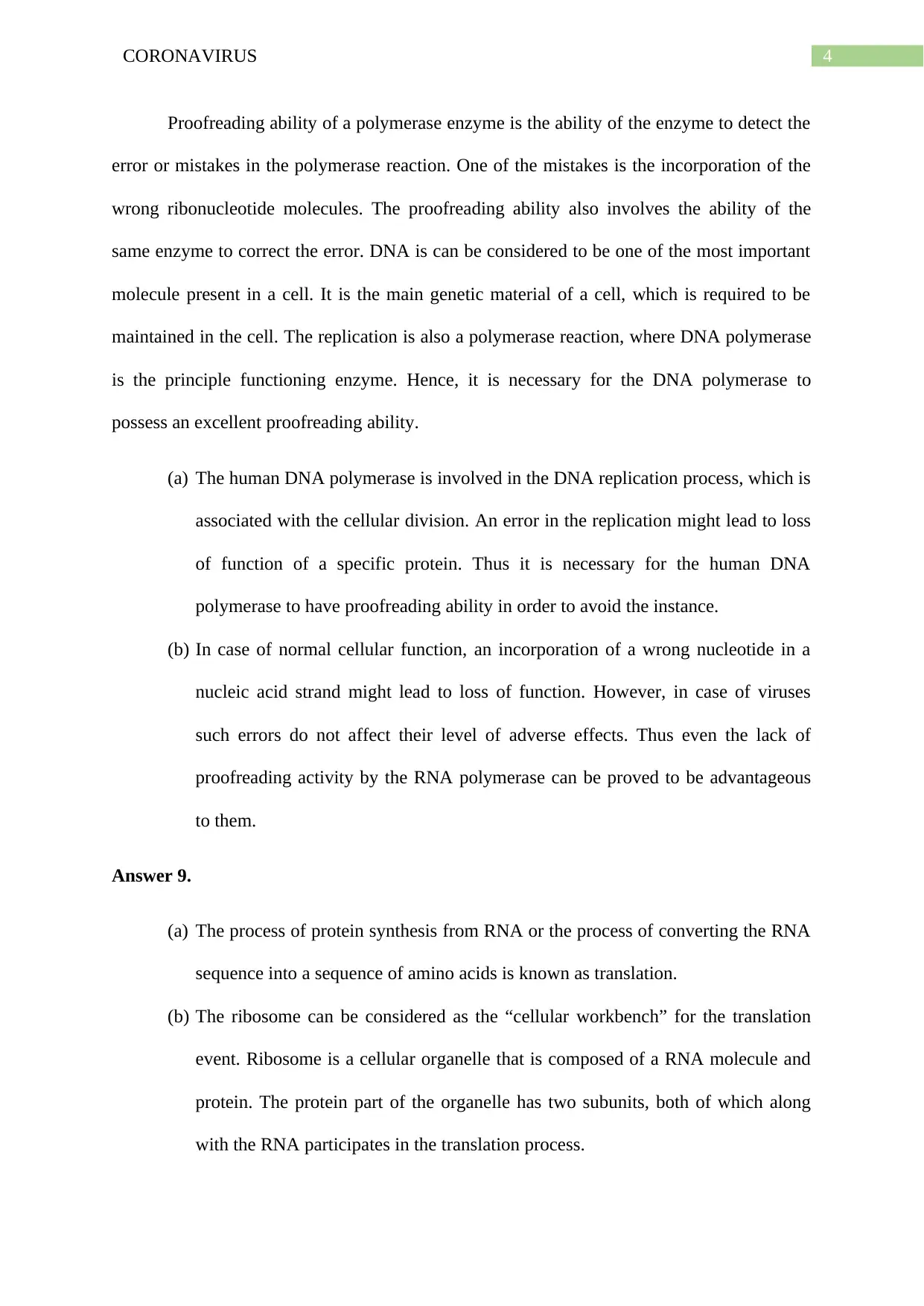
4CORONAVIRUS
Proofreading ability of a polymerase enzyme is the ability of the enzyme to detect the
error or mistakes in the polymerase reaction. One of the mistakes is the incorporation of the
wrong ribonucleotide molecules. The proofreading ability also involves the ability of the
same enzyme to correct the error. DNA is can be considered to be one of the most important
molecule present in a cell. It is the main genetic material of a cell, which is required to be
maintained in the cell. The replication is also a polymerase reaction, where DNA polymerase
is the principle functioning enzyme. Hence, it is necessary for the DNA polymerase to
possess an excellent proofreading ability.
(a) The human DNA polymerase is involved in the DNA replication process, which is
associated with the cellular division. An error in the replication might lead to loss
of function of a specific protein. Thus it is necessary for the human DNA
polymerase to have proofreading ability in order to avoid the instance.
(b) In case of normal cellular function, an incorporation of a wrong nucleotide in a
nucleic acid strand might lead to loss of function. However, in case of viruses
such errors do not affect their level of adverse effects. Thus even the lack of
proofreading activity by the RNA polymerase can be proved to be advantageous
to them.
Answer 9.
(a) The process of protein synthesis from RNA or the process of converting the RNA
sequence into a sequence of amino acids is known as translation.
(b) The ribosome can be considered as the “cellular workbench” for the translation
event. Ribosome is a cellular organelle that is composed of a RNA molecule and
protein. The protein part of the organelle has two subunits, both of which along
with the RNA participates in the translation process.
Proofreading ability of a polymerase enzyme is the ability of the enzyme to detect the
error or mistakes in the polymerase reaction. One of the mistakes is the incorporation of the
wrong ribonucleotide molecules. The proofreading ability also involves the ability of the
same enzyme to correct the error. DNA is can be considered to be one of the most important
molecule present in a cell. It is the main genetic material of a cell, which is required to be
maintained in the cell. The replication is also a polymerase reaction, where DNA polymerase
is the principle functioning enzyme. Hence, it is necessary for the DNA polymerase to
possess an excellent proofreading ability.
(a) The human DNA polymerase is involved in the DNA replication process, which is
associated with the cellular division. An error in the replication might lead to loss
of function of a specific protein. Thus it is necessary for the human DNA
polymerase to have proofreading ability in order to avoid the instance.
(b) In case of normal cellular function, an incorporation of a wrong nucleotide in a
nucleic acid strand might lead to loss of function. However, in case of viruses
such errors do not affect their level of adverse effects. Thus even the lack of
proofreading activity by the RNA polymerase can be proved to be advantageous
to them.
Answer 9.
(a) The process of protein synthesis from RNA or the process of converting the RNA
sequence into a sequence of amino acids is known as translation.
(b) The ribosome can be considered as the “cellular workbench” for the translation
event. Ribosome is a cellular organelle that is composed of a RNA molecule and
protein. The protein part of the organelle has two subunits, both of which along
with the RNA participates in the translation process.
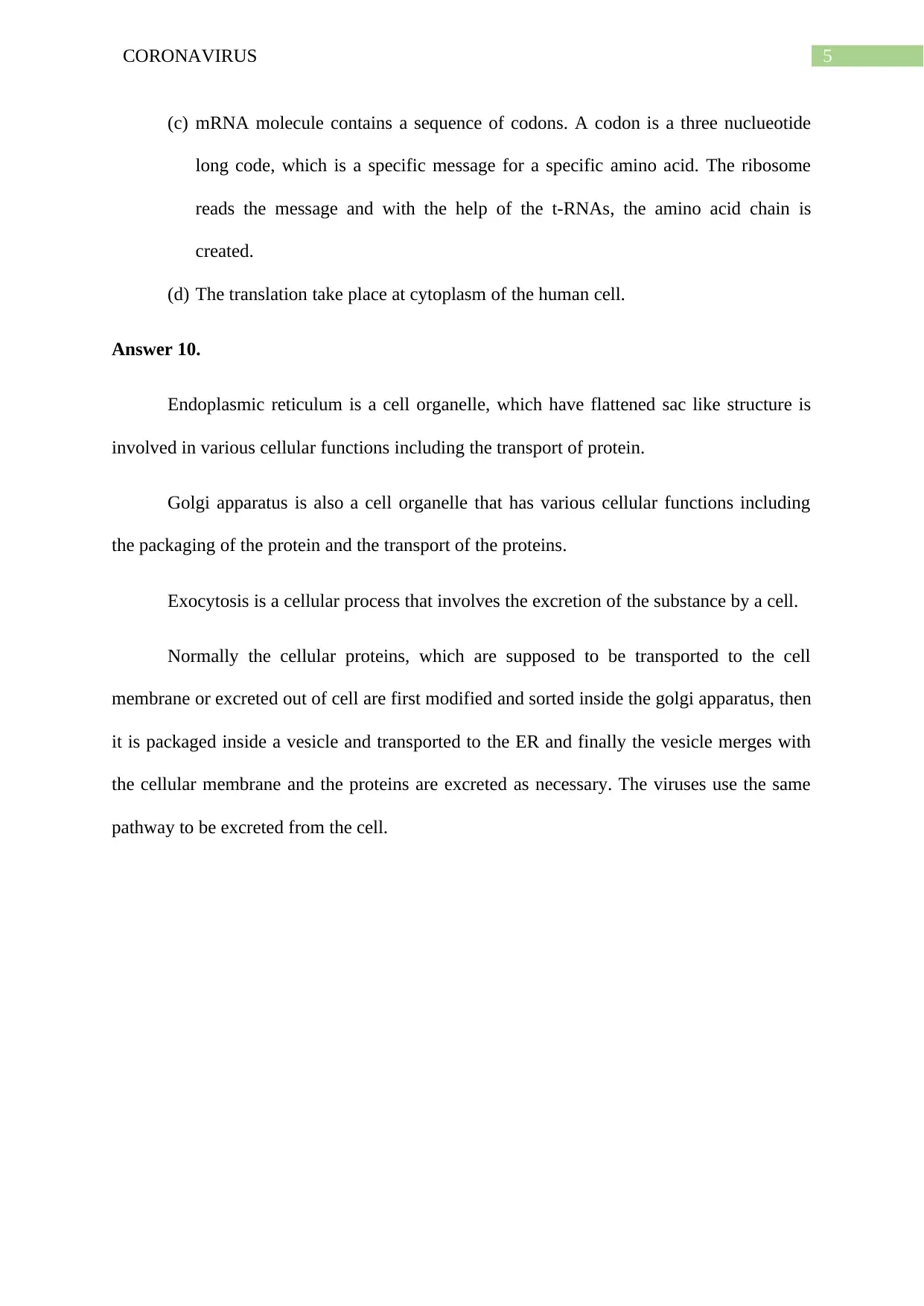
5CORONAVIRUS
(c) mRNA molecule contains a sequence of codons. A codon is a three nuclueotide
long code, which is a specific message for a specific amino acid. The ribosome
reads the message and with the help of the t-RNAs, the amino acid chain is
created.
(d) The translation take place at cytoplasm of the human cell.
Answer 10.
Endoplasmic reticulum is a cell organelle, which have flattened sac like structure is
involved in various cellular functions including the transport of protein.
Golgi apparatus is also a cell organelle that has various cellular functions including
the packaging of the protein and the transport of the proteins.
Exocytosis is a cellular process that involves the excretion of the substance by a cell.
Normally the cellular proteins, which are supposed to be transported to the cell
membrane or excreted out of cell are first modified and sorted inside the golgi apparatus, then
it is packaged inside a vesicle and transported to the ER and finally the vesicle merges with
the cellular membrane and the proteins are excreted as necessary. The viruses use the same
pathway to be excreted from the cell.
(c) mRNA molecule contains a sequence of codons. A codon is a three nuclueotide
long code, which is a specific message for a specific amino acid. The ribosome
reads the message and with the help of the t-RNAs, the amino acid chain is
created.
(d) The translation take place at cytoplasm of the human cell.
Answer 10.
Endoplasmic reticulum is a cell organelle, which have flattened sac like structure is
involved in various cellular functions including the transport of protein.
Golgi apparatus is also a cell organelle that has various cellular functions including
the packaging of the protein and the transport of the proteins.
Exocytosis is a cellular process that involves the excretion of the substance by a cell.
Normally the cellular proteins, which are supposed to be transported to the cell
membrane or excreted out of cell are first modified and sorted inside the golgi apparatus, then
it is packaged inside a vesicle and transported to the ER and finally the vesicle merges with
the cellular membrane and the proteins are excreted as necessary. The viruses use the same
pathway to be excreted from the cell.
⊘ This is a preview!⊘
Do you want full access?
Subscribe today to unlock all pages.

Trusted by 1+ million students worldwide
1 out of 6
Your All-in-One AI-Powered Toolkit for Academic Success.
+13062052269
info@desklib.com
Available 24*7 on WhatsApp / Email
![[object Object]](/_next/static/media/star-bottom.7253800d.svg)
Unlock your academic potential
Copyright © 2020–2025 A2Z Services. All Rights Reserved. Developed and managed by ZUCOL.